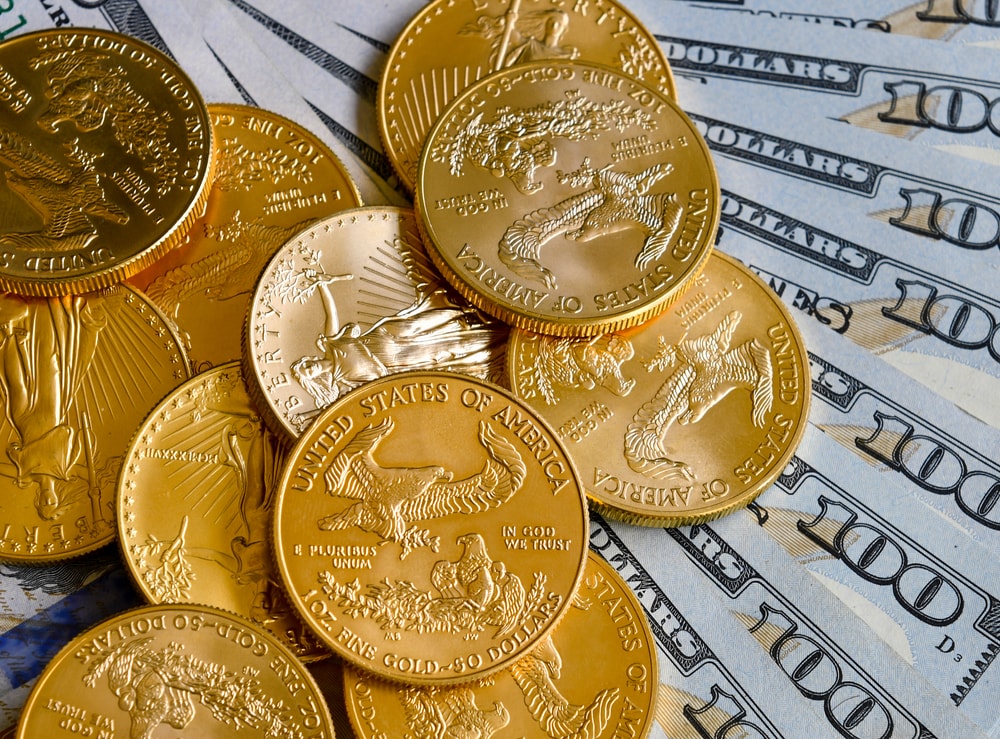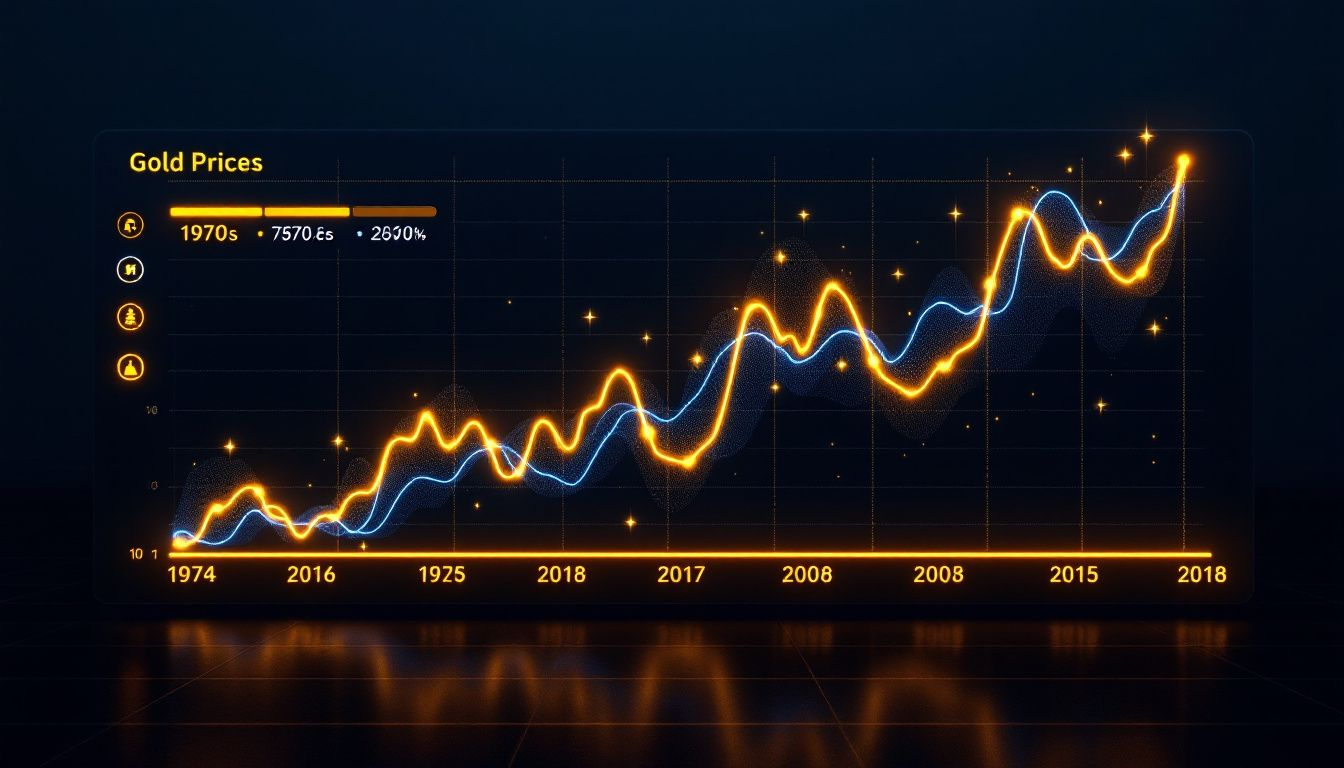In 2025, economic uncertainties in 2025 and how it can effect gold prices, such as inflation, geopolitical tensions, and central bank policies, are expected to drive changes in gold prices. Will these factors push gold prices up or down? This article breaks down what you need to know.
Key Takeaways
- Economic uncertainties in 2025, driven by inflation concerns and geopolitical tensions, are expected to keep gold prices elevated as investors seek safe haven assets.
- Gold is projected to rise by approximately 14% in 2025, averaging around $2,750 per ounce, as high inflation and low interest rates enhance its appeal as a hedge against economic instability.
- Central bank policies and the value of the U.S. dollar significantly influence gold prices, with predictions that sustained demand and geopolitical factors could drive prices to exceed $3,000 per ounce by year-end.
Economic Uncertainties in 2025: An Overview

In 2025, economic uncertainty is driven by factors like inflation concerns and geopolitical tensions. Market participants are watching macroeconomic trends closely, as these shape expectations and strategies. Trade conflicts and geopolitical issues, such as the Russia-Ukraine conflict and tensions in the Middle East, can fuel inflation and cause instability.
Many major economies are failing to meet their inflation targets, highlighting widespread challenges. This issue is compounded by the U.S. Federal Reserve’s cautious approach to interest rates amid inflationary pressures, which significantly affects market predictions and investor sentiment.
In the first quarter of 2025, investors are particularly wary of how these economic factors will unfold. The mix of economic policies, trade conflicts, and geopolitical risks creates a complex environment. These uncertainties are expected to continue influencing market dynamics and investment advice in the coming months.
Navigating the current market conditions requires understanding the interplay of these economic factors. Investors must stay informed and adaptable, given the volatile and unpredictable economy. The 2025 economic landscape highlights the ever-evolving nature of global markets and the need for vigilance.
Inflation and Its Impact on Gold Prices
Gold is widely seen as a protection against inflation, particularly when the dollar’s value declines. During high inflation, investor demand for gold typically rises, making it an attractive hedge. High inflation rates combined with low interest rates boost gold’s appeal as a safe investment. Analysts project a 14% rise in gold prices in 2025, averaging around $2,750 per ounce, supported by anticipated global economic growth.
The World Gold Council and other experts stress that gold’s role as an inflation hedge is likely to remain strong. With stable production costs for precious metals, the upward momentum in gold prices is expected to persist, making this period particularly opportune for long-term investment.
Gold prices are influenced by factors such as inflation trends, economic growth, and market sentiment. Investors closely monitor the precious metals markets to navigate the complexities of the current economic environment.
As inflation concerns continue to dominate headlines, the gold price forecast for 2025 remains optimistic, with potential for further gains.
Central Bank Policies and Gold Market Dynamics
Central bank policies significantly shape gold market dynamics. The anticipated pace of Federal Reserve interest rate adjustments in 2025 may affect gold’s price momentum, with fewer cuts than expected. A hawkish Fed policy outlook could negatively impact gold prices.
Monetary policies, especially interest rate decisions, considerably impact gold prices. Central banks have increased their gold reserves, driving prices higher as part of a strategy to diversify from traditional currencies. This trend is expected to continue, supporting gold investment.
Goldman Sachs anticipates gold prices could reach $3,000 per ounce by 2025, driven by sustained central bank demand and growing ETF investments. The relationship between gold prices and interest rates is complex and often shifts quickly in response to economic news. Despite strong performance in 2024, high interest rates may limit gold’s attractiveness.
Current market conditions reflect the intricate interplay between central bank policies and gold market dynamics. As central banks diversify from traditional reserve currencies and accumulate gold, the precious metals markets are set for continued growth. Investors should monitor central bank demand, central bank buying, and central bank purchases, as well as interest rate trends to navigate the evolving landscape.
Geopolitical Tensions and Safe Haven Demand

Escalating geopolitical tensions, conflicts, and political instability boost demand for gold as a safe haven asset. Ongoing geopolitical events in 2025, including shifts in U.S. political leadership, could further enhance gold’s appeal. The mix of geopolitical tensions and economic instability in 2025 is expected to keep gold prices elevated.
Economic uncertainty drives investors to view gold as a safe haven, seeking stability and protection amid fluctuating market conditions. The Russia-Ukraine conflict and tensions in the Middle East are examples of how geopolitical risks can influence gold prices. During global tensions, increased investor appetite for safe assets like gold is common.
Geopolitical instability often leads to a rise in safe haven demand, reflecting gold’s status as a reliable store of value. Throughout 2025, the interplay between geopolitical risks and economic factors will continue to shape the gold market. Investors should stay vigilant and consider the potential impacts of global tensions on their strategies.
The Role of the US Dollar in Gold Pricing

Fluctuations in the U.S. dollar significantly influence gold prices. Typically, a strong dollar leads to lower gold prices, while a weak dollar increases demand and prices. Understanding this relationship is crucial for making informed investment decisions in the gold market.
A favorable liquidity environment is expected to persist into 2025, benefiting gold prices. While a weaker dollar and lower interest rates typically boost gold’s appeal, this relationship has recently decoupled. The interplay between the dollar’s value and gold prices remains a key focus for investors.
The relationship between gold prices and the U.S. dollar varies over time, influenced by economic conditions and investor sentiment. Monitoring these fluctuations will be essential for predicting gold price trends in 2025. The gold market’s response to changes in the dollar’s value will remain a key factor in shaping investment strategies.
Historical Performance of Gold During Economic Crises

Historically, gold has shown resilience during economic uncertainty. During the 1973-1975 recession, gold prices surged by 87%, showcasing its strong performance during downturns. This historical context underscores gold’s role as a reliable store of value in times of crisis.
During the Covid-19 recession, gold prices rose 28% from January to August 2020. This recent example highlights gold’s ability to provide stability and protection in volatile markets. Experts predict gold prices could surpass $3,000 per ounce by 2025, reflecting ongoing economic uncertainties and investor demand.
Gold prices averaged $2,386 per ounce in 2024, significantly exceeding expectations. Historically, professional analysts have underestimated gold’s performance. Looking ahead, the historical performance of gold during economic crises offers valuable insights for investors navigating current market conditions.
Expert Opinions and Predictions
The initial target price for gold in 2025 is $2,800. If gold surpasses this target, prices could exceed $3,000. This optimistic forecast is based on a cup-and-handle pattern forming in the gold market since 2011, indicating a potential uptrend.
Overall projections suggest gold prices could exceed $3,000 in 2025. Key drivers such as central bank demand, geopolitical tensions, and economic uncertainties influence this bullish outlook. The potential for higher returns in the second half of 2025 remains strong.
Experts emphasize the importance of understanding the complex dynamics influencing gold prices. Staying informed about market trends and expert predictions in the first half of 2025 will be crucial for making sound investment decisions. The rally in gold prices is expected to continue, driven by economic and geopolitical factors.
Summary
Economic uncertainties in 2025, from inflation concerns to geopolitical tensions, are set to significantly impact gold prices. Gold’s role as an inflation hedge, coupled with central bank policies and the fluctuating US dollar, will continue to shape the market. Historical performance and expert predictions suggest a bullish outlook for gold, with prices potentially exceeding $3,000 per ounce. Understanding these dynamics is crucial for navigating the complex landscape of precious metals investment in the coming months.
Frequently Asked Questions
How does inflation affect gold prices?
Inflation drives higher gold prices by enhancing its attractiveness as a hedge against currency devaluation. As inflation rises, demand for gold typically increases, pushing its price upward.
What role do central bank policies play in gold market dynamics?
Central bank policies, especially through interest rate adjustments, play a crucial role in shaping gold market dynamics by impacting investor demand and overall market sentiment. Consequently, these policies can lead to fluctuations in gold prices.
How do geopolitical tensions drive demand for gold?
Geopolitical tensions drive demand for gold as it serves as a safe haven asset, offering stability during times of economic uncertainty. Investors turn to gold to protect their wealth, leading to increased demand.
What is the relationship between the US dollar and gold prices?
The relationship between the US dollar and gold prices is inversely correlated; a strong dollar generally results in lower gold prices, whereas a weak dollar tends to boost demand and increase gold prices.
What are expert predictions for gold prices in 2025?
Experts predict that gold prices may surpass $3,000 per ounce in 2025, fueled by central bank demand, economic uncertainties, and geopolitical tensions.
